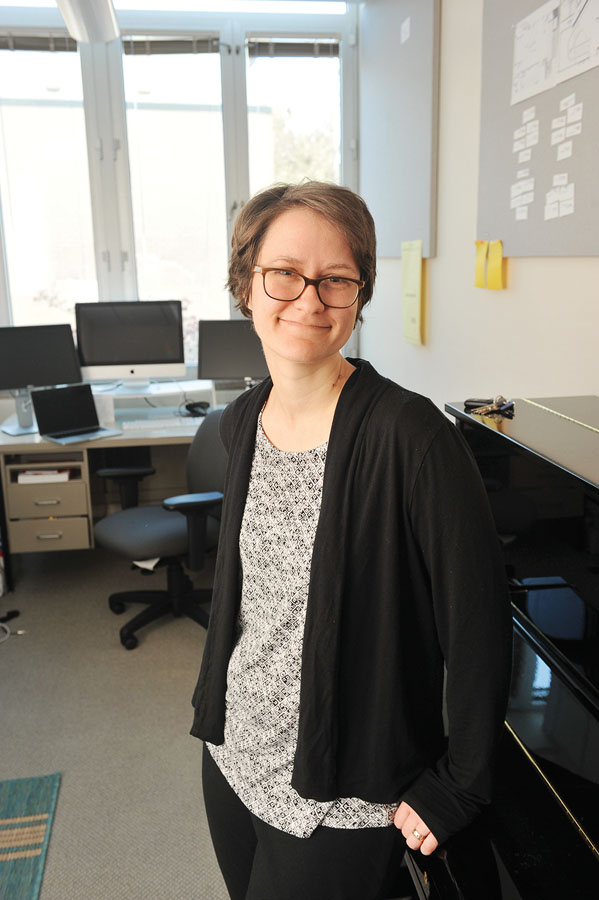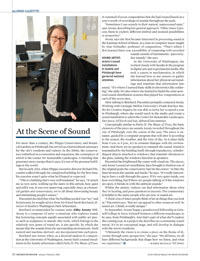Alumni Gazette
 SOUND ARTIST: Aresty’s sound installations in Seattle and Pittsburgh have garnered national attention. (Photo: Steve Pope/AP Images for Rochester Review)
SOUND ARTIST: Aresty’s sound installations in Seattle and Pittsburgh have garnered national attention. (Photo: Steve Pope/AP Images for Rochester Review)For more than a century, the Phipps Conservatory and Botanical Gardens in Pittsburgh has served as a horticultural sanctuary for the city’s residents and visitors. In the 2000s, the conservatory embarked on a renovation and expansion, the centerpiece of which is the Center for Sustainable Landscapes. A building that generates more energy than it uses, it’s one of the greenest buildings in the world.
But in early 2013, when Phipps executive director Richard Piacentini walked through the completed building for the first time, his reaction wasn’t quite what he’d hoped or expected.
“This is a building that’s very well insulated,” he says. “It struck me as very eerie, walking up the stairs in this atrium, how quiet and still it was. It was very unnerving, especially since, as a botanical garden and conservatory, we’re all about showcasing beauty and stimulating people’s senses.”
Piacentini decided that what the building needed was “art,” and fortuitously, he sought advice from his friend Sarah Reichard, director of Seattle’s Washington Park Arboretum.
Reichard recommended he contact artist Abby Aresty ’05E. Aresty is a composer of sorts—a musician who explores sound, but borrowing concepts usually associated with public art pieces such as sculptures or murals. Her work, which belongs to the relatively new genre of sound art, is site-specific, by which she means that the sounds from the surrounding environment—both natural and machine-derived—are incorporated into each piece.
Reichard met Aresty when, as a doctoral student in composition at the University of Washington, Aresty built a sound installation in the Seattle arboretum called Paths II: The Music of Trees. It consisted of seven compositions that she had created based on a year’s worth of recordings of sounds throughout the park.
“Sometimes I use sounds in their natural, unprocessed state,” says Aresty, describing her general approach. “Other times I process them to explore different timbral and textural possibilities or properties.”
Aresty says she first became interested in processing sound at the Eastman School of Music, in a class in computer music taught by Alan Schindler, professor of composition. “That’s where I first learned there was a possibility of composing with recorded sounds outside of instruments—just everyday sounds,” she says.
At the University of Washington, she worked closely with faculty in the program in digital arts and experimental media. She took a course in mechatronics, in which she learned how to use sensors to gather information about her physical surroundings and translate that information into sound. “It’s where I learned basic skills in electronics like soldering,” she adds. It’s also where she learned to build the solar-powered sound distribution systems that played her compositions at each of the seven sites.
After talking to Reichard, Piacentini promptly contacted Aresty. Working with Carnegie Mellon University’s Frank-Ratchye Studio for Creative Inquiry, he was able to invite her to spend a year in Pittsburgh, where she would teach in the studio and create a sound installation to adorn the Center for Sustainable Landscapes. Her piece, Of Earth and Sun, debuted last summer.
Conceptually similar to Paths II: The Music of Trees, the basic elements of the piece are sounds Aresty recorded throughout the city of Pittsburgh, over the course of the year. The piece is dynamic, guided by a computer program that will alter it according to the season, the weather, and the time of day. As it plays daily from 9 a.m. to 5 p.m., it’s in constant dialogue with the environment. And there are no speakers to transmit the sound. Sound is transmitted by the building itself, through transducers, cylinder-shaped objects attached to windows, that transmit vibrations to the glass, making the windows function as speakers.
Piacentini has brightened the center with visual art. The pieces, and Aresty’s sound art installation, have brought to fruition one of the original goals the conservatory had for the center: “to blur the lines between the outside and inside,” he says. “It’s really interesting to have a walk through the space. If it’s very quiet inside, you hear everything, but if there are people talking or if the windows are open, it blends in with the ambient sounds.”
Within the atrium, visitors can find information about what they’re hearing, and pose questions to docents. The commentary is helpful to the many people who are new to sound art.
“I think a lot of times people think of art as things that you look at,” Piacentini says. “But art can appeal to other senses as well. So sound art, I think, is really unique.”
In September, Aresty began a postdoctoral fellowship at Grinnell College in Iowa. Grinnell features a different soundscape, to be sure, from Pittsburgh’s. And that’s part of what she’ll explore this coming year, in a project she describes as a community sound mural. It’s in its conceptual stage, and will develop in dialogue with the town’s residents.
“Ultimately the vision is to create a piece on the theme of diversity through sonic perspective,” she says. “We all listen, we all have different backgrounds that shape how we listen, and what we experience.”
—Karen McCally ’02 (PhD)

